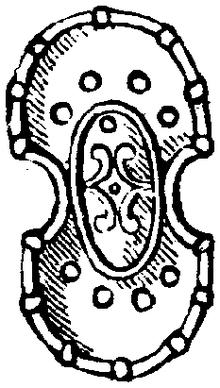
In ancient Rome, the ancilia (Latin, singular ancile) were twelve sacred shields kept in the Temple of Mars. According to legend, one divine shield fell from heaven during the reign of Numa Pompilius, the second king of Rome. He ordered eleven copies made to confuse would-be thieves, since the original shield was regarded as one of the pignora imperii, sacred guarantors that perpetuated Rome as a sovereign entity.
The ancilia were in the keeping of the Salii, a body of twelve priests instituted for that purpose by Numa.[1] The Salii wielded them ritually in a procession throughout March.
Etymology
Ancient sources give varying etymologies for the word ancile. Some derive it from the Greek ankylos (ἀγκύλος), "crooked". Plutarch thinks the word may be derived from the Greek ankōn (ἀγκών), "elbow", the weapon being carried on the elbow. Varro derives it ab ancisu, as being cut or arched on the two sides, like the bucklers of the Thracians called peltae.
Myth
When the original ancile fell, a voice was heard which declared that Rome should be mistress of the world while the shield was preserved. The Ancile was, as it were, the palladium of Rome. Numa, by the advice, as it is said, of the nymph Egeria, ordered eleven others, perfectly like the first, to be made. This was so that if anyone should attempt to steal it, as Ulysses did the Palladium, they might not be able to distinguish the true Ancile from the false ones.
References
See also
- Mars (god)
- Palladium (mythology)
![]() This article incorporates text from a publication now in the public domain: Chambers, Ephraim, ed. (1728). Cyclopædia, or an Universal Dictionary of Arts and Sciences (1st ed.). James and John Knapton, et al.
This article incorporates text from a publication now in the public domain: Chambers, Ephraim, ed. (1728). Cyclopædia, or an Universal Dictionary of Arts and Sciences (1st ed.). James and John Knapton, et al.